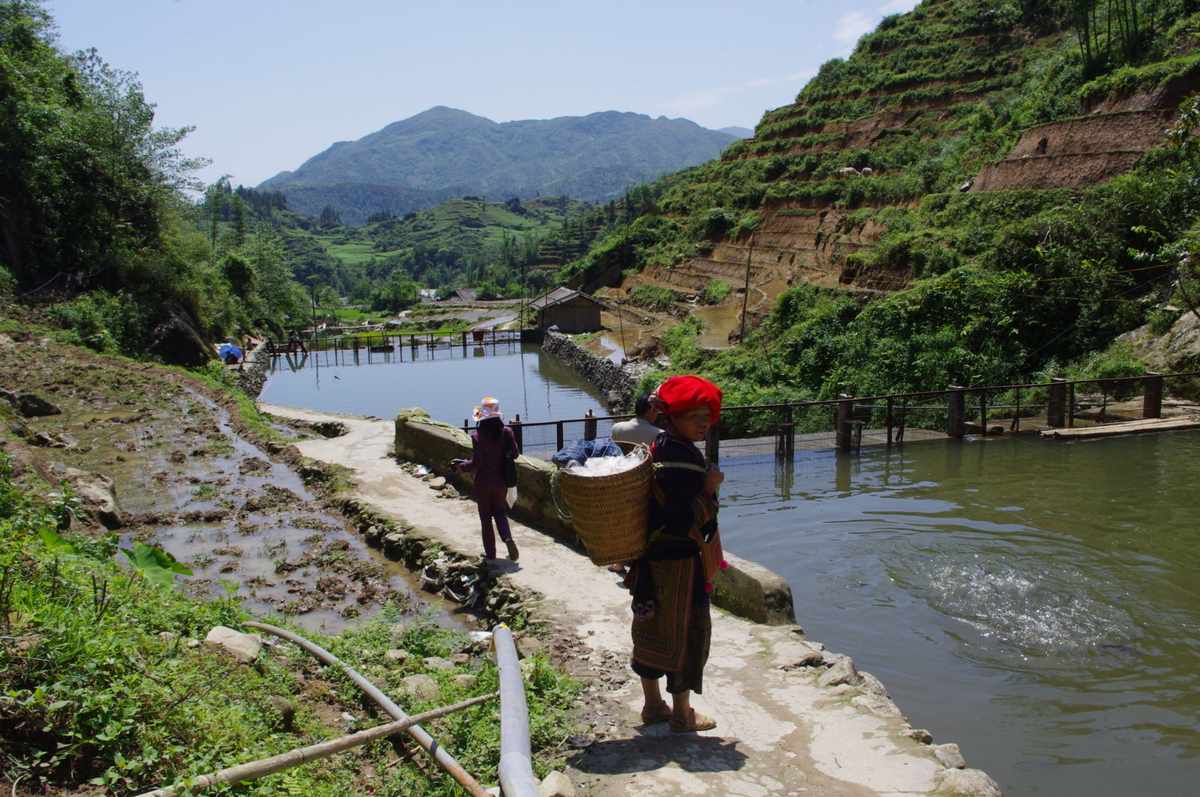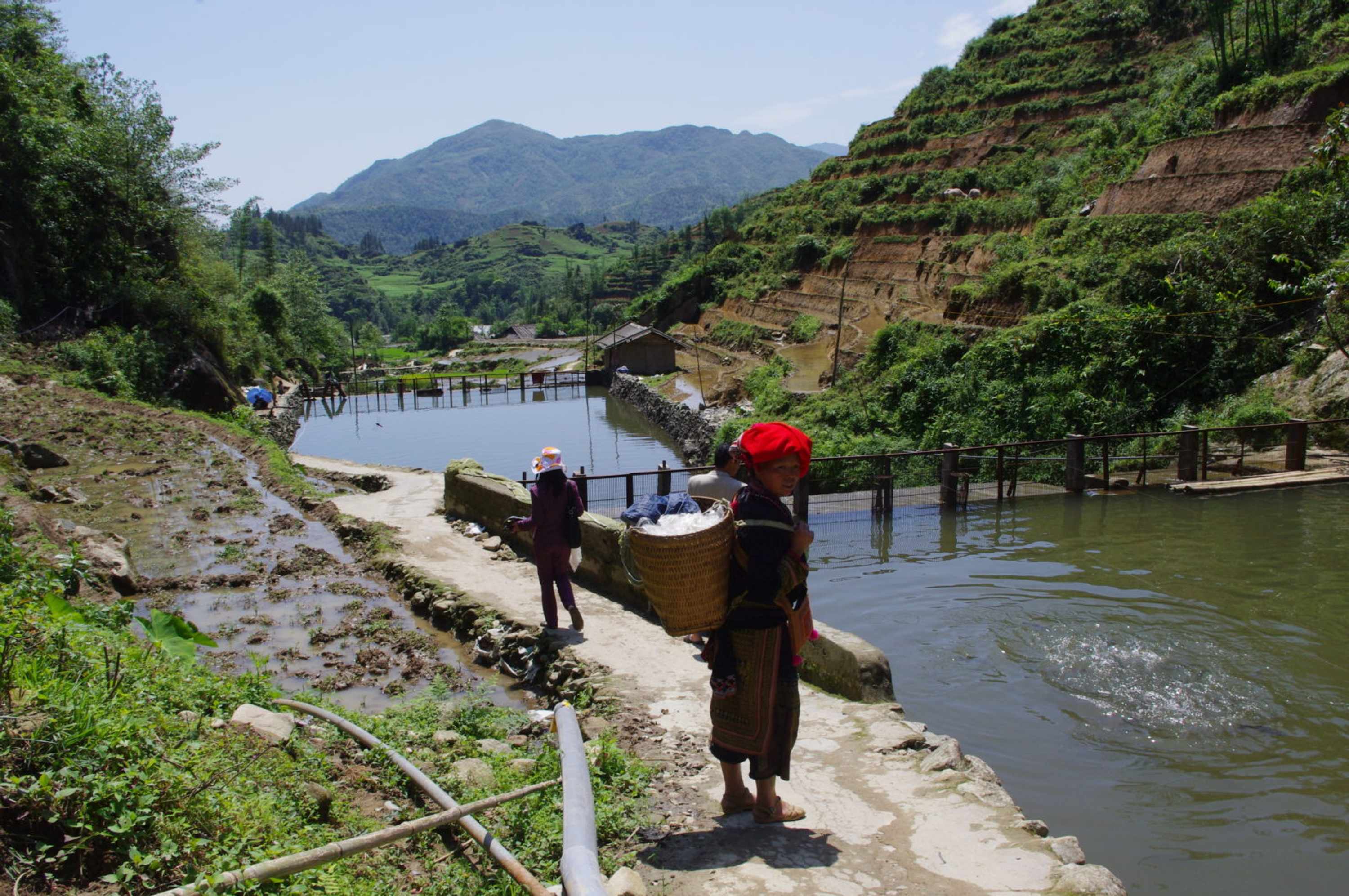Government-backed marketing boosts a booming industry but trouble could lie ahead - reflections from the departure lounge
Government-backed marketing boosts a booming industry but trouble could lie ahead - reflections from the departure lounge

 Finnish rainbow trout swimming in Vietnam
Finnish rainbow trout swimming in Vietnam
Government-backed marketing boosts a booming industry but trouble could lie ahead - reflections from the departure lounge
By ‘Nib’ We have had ‘from paddock to plate’, ‘from field to fork’, now try ‘from ovum to bowl’. I know, it lacks alliteration and the unstinting tones of the previous apophthegms. It’s the best I can do from the sanitised surroundings of the domestic departure lounge at Hanoi Airport, assailed by the now ubiquitous LED screens displaying commercial exhortation and exploitation. I gather glasses are now available to black out these screens, they have become so invasive. I’m tempted but they are yet another plastic widget to be lost, forgotten or thrown away.
Today’s looped screening to which I am being treated, is a 10-minute family piece about fish farming in Vietnam, specifically the nascent rainbow trout industry. Consumption of seafood in the east is on a staggering scale, warranting a passing glimpse at the figures for Vietnam alone. If Thailand and China are added, I shall run out of numbers.
As the example, this is solely the White legged Shrimp industry in Vietnam-
- 97,000 hectares of White Legged Shrimp (WLS) total farmed area
- 427,000 metric tonnes of WLS per annum in 2017
- WLS are worth US$ 2.5 billion per annum
- Forecast growth of 29% in 2018
- Early Mortality Disease (EMSD) and White Faeces Disease (WFD) and other serious diseases prevalent in WLS farming
- In 2013, exports increased by 113%
- In 2017 WLS accounted for 65.5% of shrimp exports
The environmental impact is substantial
In addition to white legged shrimp are the tiger prawn industry, snakehead fish farming which has had a terrible effect in the Mekong Delta, tilapia, cobia and pompano to name a few more. What strikes as insane in the food business is the exchange of goods. New Zealand lamb to the UK when we have a thriving sheep industry, UK lamb to the continent, French lamb to the UK and so on. The import/export of farmed fish in the East is vast in quantity. As in the west, sea/fresh water food products are being passed around just to create markets.
To clarify, this piece is emphatically not a criticism of Vietnam, simply a local illustration of the madness of the food industry, a microcosm of a global challenge to produce food ethically and sustainably. Similarly, in Europe after the Second World War, the Vietnam War left a country in hunger, a country which still has difficulty in feeding its population.
To create the perfect picture for the show reel, our protagonists are an ideal family of mother, father and daughter aged about 10. They are visiting a rainbow trout farm somewhere in highlands of Vietnam. There are staging shots of the tanks both above and below the water, the fish milling about and pull backs of the facility. Our family is visiting one of one hundred or so trout farms in the Central Highlands, where in the early 2000’s there was zero cold water aquaculture in the whole country, in 2009 a mere dozen. Industrial aquaculture in this geographic area is fraught with problems, including unreliable water supply, clean water, infrastructure challenges and fish health issues.
Rainbow trout is a new piscatorial choice for the Vietnamese. Its promotion must therefore be robust and convincing, its production and processing sanitised. Our family tour the facility where generous flowing running water gives the appearance of cleanliness with sharp clean concrete edges, and a generous casting of food pellets, likely containing fish derivatives and other animal by-product, bring teeming masses to the surface, greedy for more.
The daughter is clearly unwillingly pressed into netting a fish which is too heavy for her to lift out of the tank on her own; the shining and doomed creature is briefly held for the camera for comment on its conformation, then taken away for the second part of the vignette.
Cut to the imported chef who will prepare. The sound is off so I can only surmise he is giving the rainbow trout top marks for taste, texture and all-round goodness. Perhaps he is being paid by the government who wish to up the 2 million kilos of present annual rainbow trout production to total self-sufficiency by 2030, followed by the inevitable desire to export. Cold water fish production, which also includes sturgeon and other white fish, has indeed brought new wealth and some 15,000 jobs to areas in great need of being energised.
Will this be at the expense of failing to learn the lessons of fish farming in the west where massive environmental degradation has taken place, and the big issues of animal cruelty now coming to light as greater understanding of the nature of fish is revealed?
The chef’s sharp blade is now in close up, slicing a filet of trout into sushi style chunks; I am drawn into the stark rosy-pink colour of the flesh with thick streaks of fat, always a sign of farmed salmon and trout; I am being assailed with succulence and suggestion of the broad nutritional tool on display. Slices are symmetrically arranged on a board, to which are added more fish, barbecued in a metal mesh frame, the skin crisp and criss-crossed. The mother takes a piece of the barbecued trout with chop sticks, has a dip in what is either soy sauce or, perhaps gilding the lily, fish sauce, and takes the mouthful. Her report is 60 seconds long and looks detailed if somewhat forced. Vietnamese women are known to be accomplished cooks so her words are delivered from a position of knowledge; there will be respect for her opinion. She will have been chosen to fulfil this role. The father appears disinterested in the semi-background, somewhat bored by the whole shenanigan.
The owner of the facility is at times beaming with pride, at others concerned.
Then perhaps, the object of the exercise, the daughter’s opinion. This is important as over half of the 90m population of Vietnam is under 25. She is the future upon which the rainbow trout industry will depend if it is to progress from the luxury food item is now to the 2030 government target. The mother offers her daughter a piece of the barbecued fish. Bless her cotton socks, the daughter seems to be on the edge of a full-on refusal tantrum, maybe shocked by the live netting to suddenly being asked to eat the fish she caught. She has made a connection. Through gritted teeth, a small piece of fish is eaten by a face which might just as well be biting into a lemon.
This was food and social propaganda in a short film. The location in which it is being shown is important, after all flying and eating rainbow trout are both considerable luxuries here. The demographic is obvious, the aim clear - make rainbow trout the special treat next time you see it on the menu.
This aqua cultural development, as with all development of any kind here is part of the continued Revolution. And who can blame the Vietnamese for seeking prosperity, improvement in living standards, a varied diet and access to secure jobs?
May they do so however, with the lessons in mind of those who have gone before, suffering the high environmental and animal welfare costs.


